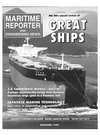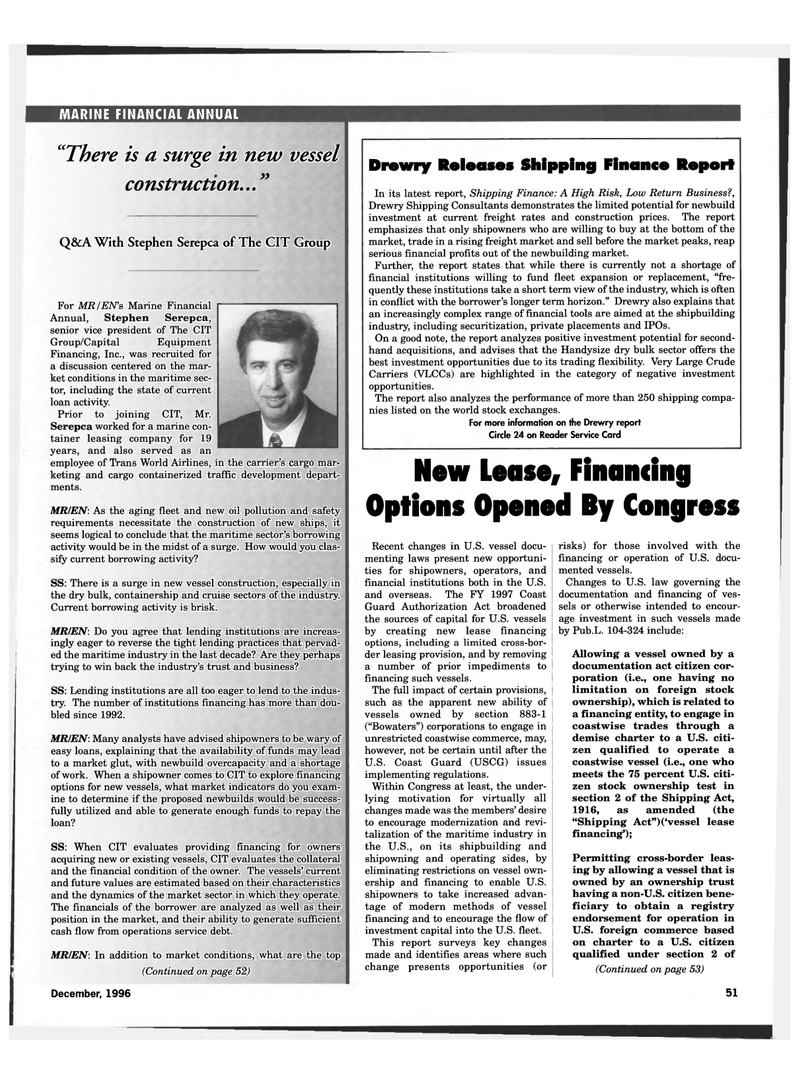
Page 49: of Maritime Reporter Magazine (December 1996)
Read this page in Pdf, Flash or Html5 edition of December 1996 Maritime Reporter Magazine
MARINE FINANCIAL ANNUAL "There is a surge in new vessel construction... »
Q&A With Stephen Serepca of The CIT Group
SS: There is a surge in new vessel construction, especially in the dry bulk, containership and cruise sectors of the industry.
Current borrowing activity is brisk.
MR/EN: Do you agree that lending institutions are increas- ingly eager to reverse the tight lending practices that pervad- ed the maritime industry in the last decade? Are they perhaps trying to win back the industry's trust and business?
SS: Lending institutions are all too eager to lend to the indus- try. The number of institutions financing has more than dou- bled since 1992.
MR/EN: Many analysts have advised shipowners to be wary of easy loans, explaining that the availability of funds may lead to a market glut, with newbuild overcapacity and a shortage of work. When a shipowner comes to CIT to explore financing options for new vessels, what market indicators do you exam- ine to determine if the proposed newbuilds would be success- fully utilized and able to generate enough funds to repay the loan?
SS: When CIT evaluates providing financing for owners acquiring new or existing vessels, CIT evaluates the collateral and the financial condition of the owner. The vessels' current and future values are estimated based on their characteristics and the dynamics of the market sector in which they operate.
The financials of the borrower are analyzed as well as their position in the market, and their ability to generate sufficient cash flow from operations service debt.
MR/EN: In addition to market conditions, what are the top (Continued on page 52)
D re wry Releases Shipping Finance Report
In its latest report, Shipping Finance: A High Risk, Low Return Business?,
Drewry Shipping Consultants demonstrates the limited potential for newbuild investment at current freight rates and construction prices. The report emphasizes that only shipowners who are willing to buy at the bottom of the market, trade in a rising freight market and sell before the market peaks, reap serious financial profits out of the newbuilding market.
Further, the report states that while there is currently not a shortage of financial institutions willing to fund fleet expansion or replacement, "fre- quently these institutions take a short term view of the industry, which is often in conflict with the borrower's longer term horizon." Drewry also explains that an increasingly complex range of financial tools are aimed at the shipbuilding industry, including securitization, private placements and IPOs.
On a good note, the report analyzes positive investment potential for second- hand acquisitions, and advises that the Handysize dry bulk sector offers the best investment opportunities due to its trading flexibility. Very Large Crude
Carriers (VLCCs) are highlighted in the category of negative investment opportunities.
The report also analyzes the performance of more than 250 shipping compa- nies listed on the world stock exchanges.
For more information on the Drewry report
Circle 24 on Reader Service Card
New Lease, Financing
Options Opened By Congress
Recent changes in U.S. vessel docu- menting laws present new opportuni- ties for shipowners, operators, and financial institutions both in the U.S. and overseas. The FY 1997 Coast
Guard Authorization Act broadened the sources of capital for U.S. vessels by creating new lease financing options, including a limited cross-bor- der leasing provision, and by removing a number of prior impediments to financing such vessels.
The full impact of certain provisions, such as the apparent new ability of vessels owned by section 883-1 ("Bowaters") corporations to engage in unrestricted coastwise commerce, may, however, not be certain until after the
U.S. Coast Guard (USCG) issues implementing regulations.
Within Congress at least, the under- lying motivation for virtually all changes made was the members' desire to encourage modernization and revi- talization of the maritime industry in the U.S., on its shipbuilding and shipowning and operating sides, by eliminating restrictions on vessel own- ership and financing to enable U.S. shipowners to take increased advan- tage of modern methods of vessel financing and to encourage the flow of investment capital into the U.S. fleet.
This report surveys key changes made and identifies areas where such change presents opportunities (or risks) for those involved with the financing or operation of U.S. docu- mented vessels.
Changes to U.S. law governing the documentation and financing of ves- sels or otherwise intended to encour- age investment in such vessels made by Pub.L. 104-324 include:
Allowing a vessel owned by a documentation act citizen cor- poration (i.e., one having no limitation on foreign stock ownership), which is related to a financing entity, to engage in coastwise trades through a demise charter to a U.S. citi- zen qualified to operate a coastwise vessel (i.e., one who meets the 75 percent U.S. citi- zen stock ownership test in section 2 of the Shipping Act, 1916, as amended (the "Shipping Act") ('vessel lease financing');
Permitting cross-border leas- ing by allowing a vessel that is owned by an ownership trust having a non-U.S. citizen bene- ficiary to obtain a registry endorsement for operation in
U.S. foreign commerce based on charter to a U.S. citizen qualified under section 2 of 0Continued on page 53)
For MR/EJSTs Marine Financial
Annual, Stephen Serepca, senior vice president of The CIT
Group/Capital Equipment
Financing, Inc., was recruited for a discussion centered on the mar- ket conditions in the maritime sec- tor, including the state of current loan activity.
Prior to joining CIT, Mr.
Serepca worked for a marine con- tainer leasing company for 19 years, and also served as an employee of Trans World Airlines, in the carrier's cargo mar- keting and cargo containerized traffic development depart- ments.
MR/EN: As the aging fleet and new oil pollution and safety requirements necessitate the construction of new ships, it seems logical to conclude that the maritime sector's borrowing activity would be in the midst of a surge. How would you clas- sify current borrowing activity?
December, 1996 51

 48
48

 50
50
